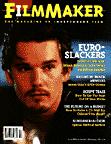 Back to selection
Back to selection
FILMMAKER FLASHBACK: WINTER, 1995
 Winter, 1995, was a great issue. Our cover story was Rick Linklater’s Before Sunrise. Andrew Hindes interviewed Linklater, Ethan Hawke and Julie Delpy, while Jean-Christopher Castelli detailed the film’s use of Austrian tax funds for its financing. Paula Bernstein interviewed James Gray about Little Odessa, and then there was one of the best pieces we’ve ever run: development executive (and, later, Oscar-winning short film director) Barbara Schock’s “The Write Stuff: Intelligent Screenplay Development.” Technology and methods of financing may change, but these notes on working with writers don’t date.
Winter, 1995, was a great issue. Our cover story was Rick Linklater’s Before Sunrise. Andrew Hindes interviewed Linklater, Ethan Hawke and Julie Delpy, while Jean-Christopher Castelli detailed the film’s use of Austrian tax funds for its financing. Paula Bernstein interviewed James Gray about Little Odessa, and then there was one of the best pieces we’ve ever run: development executive (and, later, Oscar-winning short film director) Barbara Schock’s “The Write Stuff: Intelligent Screenplay Development.” Technology and methods of financing may change, but these notes on working with writers don’t date.
From the piece:
One of the biggest impediments I’ve encountered in the development process is the widespread belief in clichéd rules of story development. Consider the almost universal belief in the old Hollywood adage that some writers can write only “character,” and others can write only “structure.” It’s important to debunk this adage because it’s a way that people developing scripts try to minimize the writer’s role in the creation of the film.
The roots of this belief are in Hollywood where an obsession with the mechanics of plot and action have to do with a desire to devise a formula for screenplays so they can imitate and repeat prior box office successes (although they usually don’t). It comes out of a misguided notion that action and plot are somehow separate from character. But the best, most psychologically interesting narratives are informed by character. In fact, the writers who are supposedly poor at structure but good with character are often the best writers, for it’s impossible to have interesting stories without believable characters and situations. In the end, what the audience remembers most are not the car chases but the characters, their relationships, what they were struggling with, and how the audience identified with them.
Schock goes on to outline her own thoughts on how to act as a story editor during the development process (i.e., how to work with a writer) and also on how to set up a development operation. I can’t recommend this article highly enough.
Winter, 1995 was also the year that we started doing a big Sundance preview section, complete with a box-office chart of the previous year’s Sundance film. (We’ve since stopped this feature because theatrical box office is no longer a useful metric when discussing the success of an indie film.) Back in the pre-digital day, filmmakers weren’t paranoid about their screeners, and it was actually pretty easy to get them to show us their films before Sundance. We previewed a dozen or so inbound Sundance pics, including Abel Ferrara’s The Addiction, which he let me see in his edit room on 18th Street at around midnight one evening a few weeks before the festival. My screening and interview ended when everyone there had to furtively dash down a back set of stairs and head to the Old Town bar… but that’s a tale for another day.
